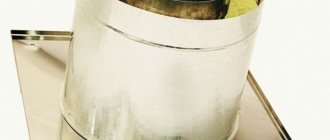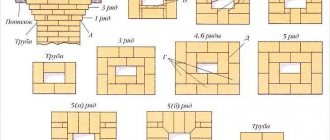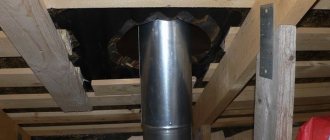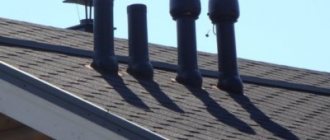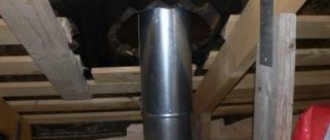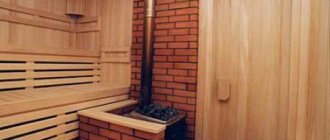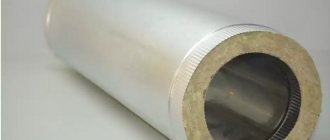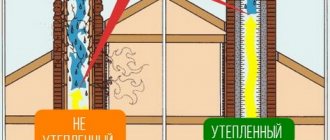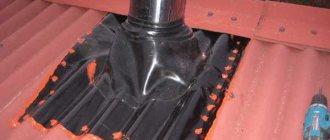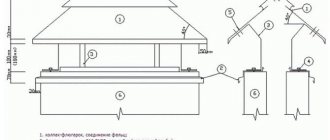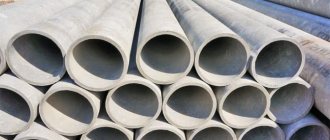Features of the structural design of chimneys
Installation of chimneys is required in houses where there is a Russian stove or fireplaces operating on solid fuel. If you want to have a real heating structure made of brick or stone, you need to choose the right location for its installation. In ancient times, people first laid out the stove, and only then built the walls.
In order not to provoke a fire hazard, you must adhere to a number of rules. Thus, it is impossible to place a large number of wooden ceiling elements above the stove, since there is a high air temperature there, which is fraught with big troubles, including the ignition of beams and ceilings.
The performance of the smoke exhaust structure depends on how straight the chimney is on the roof and its length. To ensure the required draft force, it is necessary that the air blows through the chimney at the location of the ridge or close to it.
Rapid cooling of gases appearing in the furnace shaft as a result of fuel combustion should not be allowed. Therefore, it is necessary to ensure not only the correct installation of the chimney on the roof, but also its high-quality insulation. If this is not done, condensation will constantly appear at the point of contact of warm air masses with cold ones - it will eventually saturate the chimney and begin to descend lower, destroying the structure and clogging it.
The need for a passage through the roof
If it is impossible to install a chimney from the outside, it is carried out through the roof.
A passage through the roof for a chimney may be necessary when constructing a building, installing a boiler or stove in it, or when overhauling the roof. When building a house from scratch, there are usually no difficulties with the correct installation of a chimney, since the work is organized in accordance with the project and the instructions attached to it. If a tenant decides to install heating equipment in a building that is already in use, the question arises of organizing the passage of the chimney through the roof in compliance with fire safety standards and high-quality insulation of damaged areas of the roof from moisture.
If the design of the unit allows, the smoke exhaust unit can be made outside the building. This is especially advisable when using fuel oil or diesel fuel, as it will help relieve the inhabitants of the home from the specific smell of these substances.
Selection of materials for the chimney
When constructing a stove, you need to purchase building materials correctly; this is the only way to ensure the smoke exhaust duct has optimal temperature conditions and a long service life. Materials must warm up quickly.
To build chimneys use:
- ceramics;
- metal;
- asbestos cement mortars.
Each of the listed materials has its own disadvantages - this does not allow us to call their choice ideal. Therefore, when purchasing this or that product, you should consider how suitable the product is for installing a chimney on the roof.
For example, metal structures look good, but only if an on-mount chimney is built. But making a basic model of a metal pipe will be very expensive.
When constructing the internal parts of chimneys, bricks or modules are used - materials that are fire-resistant and durable. For external sections of the structure, it is better to use asbestos-cement products.
Variety of chimney schemes
When building a chimney, one of the existing schemes is used, according to which the choice of building materials is made. If you choose it correctly, you can significantly save money and time on work.
Pipe layouts depending on the type of structure are:
- hidden - they are installed in ventilation ducts located inside the walls of buildings;
- mounted - the chimney is connected to the outlet of the air ducts of stoves or fireplaces;
- external - pipes are installed on the facade or roof;
- radical - a vertical riser is mounted on its own foundation.
Before taking the pipe outside the building, first they arrange the internal hidden areas, and then begin to construct the external chimney. Root or mounted schemes involve the exit of chimney systems through the roof or attic.
Self-construction of chimneys
The technology for installing a smoke duct has much in common with the installation of a conventional air duct. The difference lies in the presence of more stringent requirements for the operation of the chimney. Therefore, the process of arranging pipes for furnaces requires accurate calculations, selection of building materials, fasteners, refractory putties and other things.
Modular pipe
In the case where the chimney is planned to be laid in the wall of the house, this nuance should be taken into account at the stage of wall construction, otherwise the hole will need to be punched using a jackhammer. It is possible to install a stove duct in an already equipped ventilation duct, but as a result, the fire safety of the smoke exhaust structure will significantly deteriorate.
To implement a hidden pipe scheme, you need to use the services of an experienced architect, since during the operation of the furnace, temperature deformations are possible - the dimensions of the channel increase from the influence of hot gas, thereby exposing the walls to destructive processes.
Chimney sections inside load-bearing structures can be constructed from multilayer blocks. They are placed over the entire surface of the wall, using a temperature-resistant adhesive for fixation. This material is able to level out thermal deformations, thanks to damper gaskets, and thereby ensure the integrity of the building.
The main advantage of this design is that there is no need to insulate the pipe on the roof of the house - the channel will go outside above the roof level inside the gable.
Mounted steel chimney
Installing steel chimneys does not require special skills or a lot of time, so they are often preferred by homeowners, and such structures are relatively inexpensive.
It should be taken into account that:
- Any metal pipe must consist of at least two parts and must be disassembled accordingly. After a few years, the first section burns out from high temperatures, not the entire structure will need to be replaced, but only a section of it.
- Where the chimney will be brought out through the roof and wall, fire-resistant insulation is laid, otherwise the building may catch fire.
- The section of the pipe located in an unheated room must be properly insulated so that cold air masses do not cool the gas and thereby affect the performance of the heating unit. As a result, condensate will not collect on the surface of the pipe and it will not rust.
- It is imperative to waterproof metal pipes using non-combustible materials.
Install the metal shell structure in stages:
- The first elbow is placed on the screen pipe or on the outlet of the furnace air duct.
- The second ring is brought out through the attic into the room and fixed on a fire-resistant spacer.
- Connect both knees.
- The third segment is led out into the attic through a through opening in the roof. The place where the pipe exits to the street is covered with a spherical casing.
Root brick pipe
This type of brick stove chimney will last for many years. The main pipe is installed on a foundation, which is laid separately during the construction of the basement floor.
The installation technology of this chimney is more complex than that of a mounted metal structure. The fact is that the main pipe must withstand the longitudinal load from the weight of the entire unit, so it is laid out from baked bricks.
Features of the structure:
- To build a chimney channel, leave a hole the size of a brick or half a brick. To lay one layer, 4-6 bricks will be enough.
- The layers are laid out so that the bottom joining seam of the row is under the whole brick.
- Before the chimney pipe is brought out through the roof, a special module is made in the place where it passes through the ceiling to shift the axis of the section piercing the roof relative to the axis of the part of the chimney located in the room.
The design of this type is complex, and it is installed when there are no other options.
External chimney
A pipe mounted from metal or asbestos-cement modules is installed along the facade of the building, moving in the direction from bottom to top.
External structures have the following features:
- in the place where the pipe enters the building, a hole is made, through which a horizontal segment of the chimney is then brought out;
- the junction of the horizontal and vertical sections is designed in the form of a tee, one part of which is closed with a plug. This element is used when cleaning the chimney;
- the pipe is attached to the facade using detachable metal clamps. The lower part of the chimney is strengthened with a superstructure specially erected on a separate foundation.
Choosing a location for the chimney on the roof
The pipe should be located near the highest point of the roof
When organizing a penetration for the chimney, it is important to correctly select the location for the outlet channel on the roof. The pipe should be located near the highest point of the roof. In this case, a number of fire safety requirements must be observed:
- cross-sectional dimensions and height are selected based on the advice of the manufacturer of the heating equipment used;
- you need to remember the direct correlation between the height of the chimney duct and the resulting draft force of the unit;
- the channel should end 0.5-1.5 m above the roof ridge;
- in order not to damage the rafter system, the outlet is placed between its components;
- if the pipe will be located low on the slope, you need to make it long to fit into the recommendations regarding the elevation above the roof elements;
- the structure is made up mainly of vertical parts of tubes (horizontal lengths are no more than 1 m).
Passage units should not be placed near attic windows, otherwise the wind will blow fuel combustion products into it. At the junction of the slopes that form the internal corner, this is also not worth doing. It is difficult to achieve a good connection to the pipe there. In addition, in winter, snow accumulations appear in these areas. The chimney structure must not be rigidly fastened to the roof: if the latter is damaged, the pipe may collapse. It also increases the likelihood of a fire.
A few tips from the master
To perform a quality installation, you need to have knowledge of how to properly install a pipe on the roof and have the appropriate skills. Installing a chimney is associated with great risks, so you should not forget about safety measures when work is carried out on the roof of a house.
Here are some recommendations from experts:
- If the decision is made not to build a separate box for the chimney below, it is necessary to ensure a gap between the chimney structure and the combustible materials used for the walls.
- The section of the chimney that will be located outside must be made without joints. When this is not possible, the connection should be made above the point where the pipe exits the ceiling, without coming into contact with the sheathing and roofing. The joints are tightened with iron clamps, covered with asbestos material and secured.
- If you want to lay a brick chimney, you need to purchase special baked bricks, using clay or strong grades of cement for laying.
- If you are not sure that you will be able to build a brick chimney yourself, then it is better to purchase a ready-made structure. The homeowner will only have to study the information on how to secure the pipe to the roof. Today, there are insulated and protected chimney systems on sale that do not need to be coated with asbestos and treated with mastic.
- To improve the fire protection of a structure, you need to put a canopy on it to protect it from accidental sparks and precipitation.
Carrying out penetration depending on different types of roofing
The roof penetration will vary depending on the shape of the chimney and the material that covers the roof. Thus, to install a sandwich pipe, installation of a heat-insulating box is not required, since the insulation here is laid during manufacture. To penetrate the roof of a brick or ceramic chimney, it is necessary to construct a thermal insulation box to protect the building from fire.
Elastic penetration for round pipe
The simplest but most universal penetration exists for a sandwich pipe. It is a rubber or silicone pyramid that is put on the pipe and fixed to the roof. Moreover, the smoothness of the roof covering in this case does not matter much - the elastic insulating apron is equally hermetically attached to the ribbed surface of the profile, wavy tiles, and soft ondulin. Manufacturers offer ready-made flexible penetrations for sandwich chimneys of any cross-section.
Installation of elastic penetration is carried out as follows:
- A hole is cut in the roof for the pipe outlet so that at least 38 cm remains from the pipe wall to the combustible roofing materials.
- A galvanized metal sheet with a hole for the chimney is fixed to the inside of the roof. The distance from the outer wall of the pipe to the edge of the sheet hole is at least 14 cm.
- Remove the pipe and secure it in the desired position.
- The elastic penetration pyramid is cut to a level corresponding to the diameter of the pipe and put it on the pipe through the top.
- The protective apron of the penetration is applied to the chimney passage, having previously coated the edges with fire-resistant sealant.
- A metal mounting ring (flange) with holes is placed on top and secured with self-tapping screws.
For roofs with a steep slope angle, manufacturers produce special elastic penetrations, where the slope of the pyramid and apron is more pronounced.
Note! The elastic penetration material is designed to withstand significant changes in external temperature and is resistant to sunlight and moisture.
Metal penetration for round pipe and smooth roof
A metal feedthrough for a round pipe can also be purchased ready-made. It is a metal cone, the upper hole of which corresponds to the diameter of the chimney pipe. When choosing a metal penetration, you need to know the angle of inclination of your roof.
We recommend that you read: How to build a garage from a profile pipe?
Installation diagram for metal penetration:
- the hole in the roof and the inside of the protective structure are designed as for elastic penetration;
- a passage pipe is put on the chimney, the edges of the lower part are coated with fire-resistant sealant;
- secure the protection with self-tapping screws with rubber caps to seal the mounting holes.
Note! A steel passage pipe is used to design the chimney penetration only for smooth roofs.
